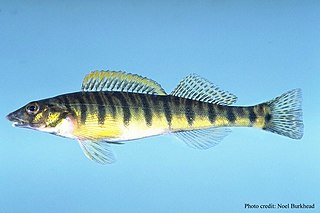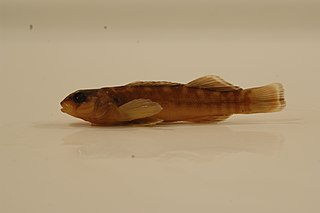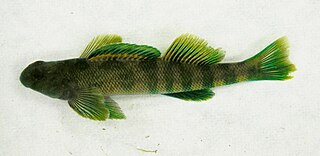
Percina is a genus of small freshwater ray-finned fish, classified within the subfamily Etheostomatinae, part of the family Percidae, which also contains the perches, ruffes and pikeperches from North America. Along with similar fishes in certain other genera, members of Percina are commonly called "darters". More specifically, the genus as a whole is known as roughbelly darters, while certain species of Percina with a pattern of vertical bars on the flanks are called logperches.

The leopard darter is a species of freshwater ray-finned fish, a darter from the subfamily Etheostomatinae, part of the family Percidae, which also contains the perches, ruffes and pikeperches. It is native to the United States, where it can be found only in the Little River drainage in Oklahoma and Arkansas. Its typical habitat is medium to large streams with rubble and boulder substrate. It feeds on small invertebrates on the riverbed and spawns mainly in March and April. It is threatened by impoundment, habitat loss and runoff from agricultural activities. It has never been a common species and has been listed as a threatened species in the United States since 1978, and the International Union for Conservation of Nature lists it as a "vulnerable species".
Percina austroperca, the southern logperch, is a small species of freshwater ray-finned fish, a darter from the subfamily Etheostomatinae, part of the family Percidae, which also contains the perches, ruffes and pikeperches. They are highly resilient with a minimum population doubling time of less than 15 months. It is found in the Escambia and Choctawhatchee river systems in western Florida and southern Alabama.
Etheostoma pallididorsum, the paleback darter, is a species of freshwater ray-finned fish, a darter from the subfamily Etheostomatinae, part of the family Percidae, which also contains the perches, ruffes and pikeperches. It is endemic to Arkansas in the United States. It is only known to occur in the Caddo River and in Hallmans Creek, a tributary of the Ouachita River. This species inhabits headwaters and creeks where it lives in rocky, shallow pools and also in springs with plentiful vegetation growth. This species can reach a length of 6 centimetres (2.4 in) TL though most only reach about 3.9 centimetres (1.5 in).

Percina burtoni, the blotchside logperch or blotchside darter, is a small, endangered species of freshwater ray-finned fish, a darter from the subfamily Etheostomatinae, part of the family Percidae, which also contains the perches, ruffes and pikeperches. It is endemic to the United States and classified as vulnerable on the IUCN Red List.

The bluestripe darter is a species of freshwater ray-finned fish, a darter from the subfamily Etheostomatinae, part of the family Percidae, which also contains the perches, ruffes and pikeperches.
The freckled darter is a species of freshwater ray-finned fish, a darter from the subfamily Etheostomatinae, part of the family Percidae, which also contains the perches, ruffes and pikeperches. It is endemic to the United States.
The longnose darter is a species of freshwater ray-finned fish, a darter from the subfamily Etheostomatinae, part of the family Percidae, which also contains the perches, ruffes and pikeperches. It is endemic to the United States.
The stargazing darter is a species of freshwater ray-finned fish, a darter from the subfamily Etheostomatinae, part of the family Percidae, which also contains the perches, ruffes and pikeperches. It is endemic to the United States.
Percina macrocephala, also known commonly as the longhead darter, is a species of freshwater ray-finned fish, a darter in the subfamily Etheostomatinae, part of the family Percidae, which also contains the perches, ruffes, and pikeperches. P. macrocephala is endemic to the United States.
The sickle darter is a recently identified freshwater ray-finned fish, a darter from the subfamily Etheostomatinae, part of the family Percidae, which also contains the perches, ruffes and pikeperches. It is closely related to a well-known darter, Percina macrocephala. Discovered in 2007 in the upper Tennessee River drainage, the sickle darter is around 90.5 mm (3.56 in) in length and is a slender bodied, freshwater and benthopelagic fish that most likely feeds on small crayfish and mayflies, since it shares a large mouth and long snout with its sister species. The known distribution of the sickle darter is the upper drainage of the Tennessee River of Tennessee, North Carolina and Virginia. It is distinguished from all other Percina darters except its sister species P. macrocephala by a dark suborbital bar and a black bar subtending a medial black spot on the base of the caudal fin. It stays in mostly rocky, sandy, or silty substrates in clear creeks or small rivers in the Appalachian Mountains. The sickle darter spawns in late winter in gravel shoals. It also has large scales which make it different from macrocephala. It's known to be extirpated from most of its home habitat mainly because of agricultural practices that cause siltation and turbidity which causes most populations of the sickle darter to be widely scattered. But where it is found, it can be observed with regularity. Taking all this into consideration, the sickle darter does not have a formal conservation status under any federal or state law although its closely related species is considered a species of concern by the TWRA. Future management plans should include finding more locations of the sickle darter and decreasing further habitat destruction in known distributions by stating it as a fish of concern by state law.
Percina peltata, the shield darter, is a species of freshwater ray-finned fish, a darter from the subfamily Etheostomatinae, part of the family Percidae, which also contains the perches, ruffes and pikeperches. It is endemic to the eastern United States.

The orangebelly darter is a species of freshwater ray-finned fish, a darter from the subfamily Etheostomatinae, part of the family Percidae, which also contains the perches, ruffes and pikeperches. It is endemic to the eastern United States, where it occurs in the Ouachita and Red River drainages in southwestern Arkansas and southeastern Oklahoma. It occurs in gravel and rubble riffles and runs of creeks and small to medium rivers. This species can reach a length of 8.5 cm (3.3 in).
The Arkansas saddled darter is a species of freshwater ray-finned fish, a darter from the subfamily Etheostomatinae, part of the family Percidae, which also contains the perches, ruffes and pikeperches. It is endemic to the eastern United States, where it occurs in the White River drainage in Arkansas and Missouri. It occurs in deep, fast gravel and rubble riffles of small to medium rivers. This species can reach a length of 12.0 cm (4.7 in).

The Creole darter is a species of freshwater ray-finned fish, a darter from the subfamily Etheostomatinae, part of the family Percidae, which also contains the perches, ruffes and pikeperches. It is endemic to the Eastern United States, where it occurs in the Ouachita, Red, Calcasieu and Sabine River drainages in Arkansas and Louisiana. It inhabits gravel riffles, current-swept vegetation and debris in creeks and small to medium rivers. This species can reach a length of 7.4 cm (2.9 in). The creole darter was first formally described in 1969 by Ray S. Bridsong and Leslie William Knapp with the type locality given as the Dugdemona River, Jackson Parish, Louisiana.

The Guadalupe darter is a small species of freshwater ray-finned fish, a darter from the subfamily Etheostomatinae, part of the family Percidae, which also contains the perches, ruffes and pikeperches. It is found in the Guadalupe River system in Texas. It prefers fast rocky runs of small to medium-sized rivers. The darter is typically 11.0 cm (4.3 in) in length.
The Ozark logperch is a species of freshwater ray-finned fish, a darter from the subfamily Etheostomatinae, part of the family Percidae, which also contains the perches, ruffes and pikeperches. It is found in North America in the Meramec River, the southern tributaries of the Missouri River in Missouri and Kansas, and the Arkansas River system in Arkansas, Missouri, Kansas, and Oklahoma. It prefers gravel runs and riffles of small to medium-sized rivers.
The bigscale logperch is a species of freshwater ray-finned fish, a darter from the subfamily Etheostomatinae, part of the family Percidae, which also contains the perches, ruffes and pikeperches. It is native to North America where it occurs in the Sabine River of Louisiana, the Red River of Oklahoma and Arkansas, and to the Rio Grande drainage of Texas, New Mexico, and Mexico. It is now widespread in the Arkansas River basin where it was likely introduced. It was introduced to the Sacramento-San Joaquin River drainage in central California, and in reservoirs fed by the California Aqueduct where it is also widespread.
The sharpnose darter is a species of freshwater ray-finned fish, a darter from the subfamily Etheostomatinae, part of the family Percidae, which also contains the perches, ruffes and pikeperches. It is found in North America where it occurs in the southern tributaries of upper Ohio River, to the Kentucky River in Kentucky, south in the New River drainage to North Carolina. It prefers gravel runs and riffles of small to medium-sized rivers.

Etheosomatidae is a species-rich subfamily of freshwater ray-finned fish, the members of which are commonly known as the darters. The subfamily is part of the family Percidae which also includes the perches, ruffes and pikeperches. The family is endemic to North America. It consists of 3-5 different genera and well over 200 species.








